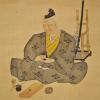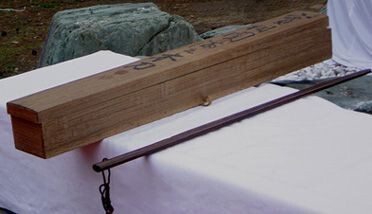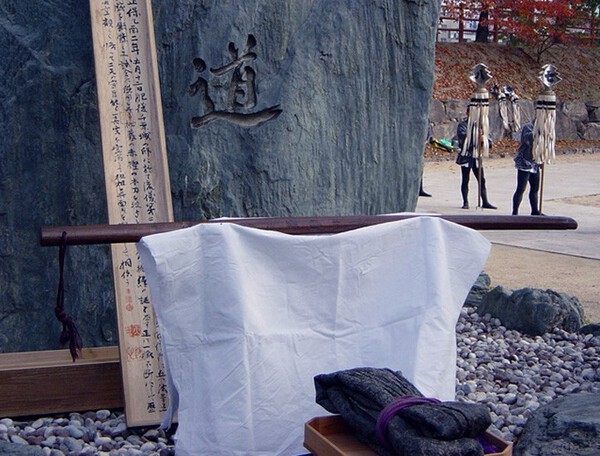-
Posts
151 -
Joined
-
Last visited
-
Days Won
1
Tim Evans last won the day on September 27 2018
Tim Evans had the most liked content!
Profile Information
-
Location:
Denver area USA
Profile Fields
-
Name
Tim E
Recent Profile Visitors
The recent visitors block is disabled and is not being shown to other users.
Tim Evans's Achievements
-
For similarities there is the oval seppadai and some similarities in the details of the dragons, which admittedly is hard to see in the pictures. Also, these two are a rare examples of a figural presentation rather than repetitive design elements. Based on Sasano's research presented in Tosogu no Kigen the hitsuana on mine looks like a period 2 rounded oval. The hitsu also appears to be cast in the plate, so would date to early Muromachi. the hitsuana for #10 in the book looks more like mid Muromachi, however, I cannot tell if the hitsu is original to the plate or cut in later. Robert Burowoy in The Picture Book of Old Tsuba relates a theory that decoration some of these cast tsuba resemble cast Buddhist votive objects and could have been made by the same craftsmen. I think with the rise of the professional tsuba smiths in the Edo period, these rather naïve tsuba probably were no longer desirable. Does anyone have thoughts on the English descriptions? I find the dates a bit ambitious.
-
Here is another that is ascending and descending dragons. The plate is only about 1mm thick in spots. I think the two holes at the bottom were casting flaws modified to look like bottles. I see some similarities to #10 in Sasano's book.
-
I have made fitted fuchi-gashira box inserts. I used balsa wood for the insert, it is readily available in hobby shops or online in various thicknesses and is very easy to work with hand tools. I will describe using inch measurements, I assume there are equivalent metric sizes. This is just a general outline, various dimensional adjustments may be needed depending on how big the fuchi and kashira are. Cut a 1/4 inch thick piece of balsa wood to fit inside the box. Make it a little small since it will be wrapped in fabric. Cut a 1/8 inch thick piece of balsa wood the same size. This will hold the fuchi. Locate where you want the fuchi to sit, then cut the hole for the fuchi in the 1/8 piece. It should be a little tight. Glue a piece of fabric on the 1/4 inch piece where the fuchi hole will show through. Glue the 1/8 piece on top of the 1/4 piece. Locate and cut the slot for the fuchi. Think about how high you want the insert to sit. If too low, then you may want to glue another balsa wood board on the bottom. A board on the bottom also helps it look more finished. Some adjusting will need to be done to the holes since you want a little friction to hold the items in place, but are also easy to pull out. cut a piece of fabric to go over the top and down the sides. Glue this on. This is the fussy part. carefully cut the fabric covering the holes so that you can fold the fabric over the edges of the holes and glue them down. The fuchi hole will need additional small pieces of fabric to line the sides and the bottom. I have also used this method to make press in liners for menuki and tsuba boxes.
-
Question for Brian. if I scanned this booklet and it was posted in the Downloads section for free personal use, do you think there would be copyright issues?
-
I don't know if there is an unofficial translation or not, but the copy I have came with a 10-page booklet with English descriptions of each tsuba plus a forward and afterword. I assume it was original to the book since it is nicely printed. Apparently these inserts have been lost over time.
-
In the Downloads section in Free Nihonto Books there is Token Zukou [Pictorial Study of Japanese Treasury Swords] Volumes 1 and 2 that have fairly accurate drawings of tanto type koshirae from shrines, temples and private collections that date to 14th century. I would be skeptical of the accuracy of old Edo prints for references on that time period. There are some old scrolls that may be helpful, such as the one used by Sasano in Tosogu no Kigen.
-

World War II Sword, Maybe?
Tim Evans replied to garbage finds's topic in General Nihonto Related Discussion
Let's discuss the structure of the hilt, or tsuka, in Japanese. The cloth wrap (tsuka-ito) is silk, and after 70 or so years it is probably going to be dried out and easily frayed. There are paper pads underneath the tsuka-ito. Underneath that is a layer of same', which is the hide of a type of ray fish. The same' can also be dried out and loose, inspect for cracks and losses. It can be held on to the tsuka with glue which should be assumed to be water soluble. The core is made of wood, usually hinoki. There may be some cracks in the wood, but usually those are best left alone. Old tsuka can be cleaned, the best approach is least intrusive method first. So first step is to inspect and decide how intact it is, anything loose or falling off? If not, then as John recommends a slightly damp rag with mildly soapy water is probably the first step and proceed slowly. Not recommended is to soak it thoroughly or to use a brush, which will fray the tsuka ito -
Consider that the mei is a brand, so the thinking is that signed on the front means a tsuba made as shop stock for sale to the public. Signed on the back is thought to mean this was a custom order, and would be presumptuous or tacky to obviously stick the brand on the front. There are also tsuba by known masters that are unsigned, which can mean the tsuba smith was a retainer to a Daimyo and produced tsuba or other fittings only for the Daimyo family, and were not ever for sale, so no need to brand them. This situation does not apply to the thousands of unsigned low end tsuba.
-

What makes a sword a masterpiece?
Tim Evans replied to Hoshi's topic in General Nihonto Related Discussion
I suspect Paul's Visions within Visions essay is not included. However, here is another example of his writing on nihonto aesthetics that is available online. https://jssus.org/1977V9_Bulletin.pdf It was found in the Japanese Sword Society of the United States Newsletter Archive. https://jssus.org/ -

Swords of the 47 Ronin
Tim Evans replied to Utopianarian's topic in General Nihonto Related Discussion
I pulled this off of a Japanese site years ago. "Musashi has many talent. He made sword fittings. Terao-Nobuyuki, Musashi's best pupil received a Musashi self-made koshirae. Sword is 81.8cm Kaneshige. Kashira is Hana-kukuri shape horn. kojiri is horn too. Fuchi is copper with hammer pattern. Tsuba is "Namako-sukashi" copper. Tsuka with horse leather Tsuka-ito". This sword is also described is the book, Zukan Toso no Subete on pages 58 and 59. The swordsmith is Izumi no Kami Fujiwara Kaneshige of Echizen. Also, there are two swords, a katana and wakizashi by Kawachi no Kami Nagakuni that are documented as being used by Miyamoto. Bokuto On the web page for the Hyoho Niten Ichi-ryu https://www.hyohonitenichiryu.com/global/english/ a bokuto made by Miyamoto called the Jisso Enman no Bokuto is mentioned. A detailed description is here https://www.hyoho.com/embo.html -

What makes a sword a masterpiece?
Tim Evans replied to Hoshi's topic in General Nihonto Related Discussion
Paul is a member of the Northern California Japanese Sword Club, and he and I have had very interesting conversations at their annual event, the San Francisco Token Kai. The last time I saw Paul was pre-Covid, but I believe he is still alive, he must be in his early 90's. He was a part of the Bob Haynes, Alan Harvie (deceased), and Keith Austin (AKA, the swordsmith NobuHira, also deceased) group of friends. John Yumoto was a mentor to members in the club, and opened doors to westerners seeking more knowledge in Japan. Two points: Paul describes that learning to see a good sword and developing a depth of vision is a never ending process that is best pursued with guidance from a more experienced person. He described this in the "Sensei Trouble: I Was Certain It Was A Trick" section, where Albert pointed out a section of kinsuji on a sword, but Paul could not see it or describe it. Albert said "you are not ready to see it yet" and put the sword away. Sometime later, the same sword was out for a different lesson and Paul saw the kinsuji, right where Albert said it was. Secondly, nihonto is a Japanese art form, and I tend to defer to what the Japanese prioritize as being more aesthetically important or in better taste (even though I may not understand why), rather than try to impose my own cultural ideas of what I find exciting or stimulating. This is one reason why as a tsuba collector, I prefer to study the mysteries of high quality iron tsuba (the aesthetics are very similar to nihonto) rather than chase the obviously pretty Edo period kinko, which to most kinko collectors, look like crude mud pies and therefore dismissed. -

What makes a sword a masterpiece?
Tim Evans replied to Hoshi's topic in General Nihonto Related Discussion
It is a wide ranging essay, so succinctly summarizing might be difficult. Below is a list of the topic headings that will provide an idea of the scope. Visions within Visions The Nature of Aesthetics and the Japanese Sword as Fine Art by Paul R. Allman Introduction: In Whose Eye is Beauty? The Sword as Beauty: How I first saw it. Is any Art Rubbish If no One Appreciates It? “Craft”, “Art” and the Sword: Some Definitions. Why Worry About It?: We Know the Sword is Art. What’s Ahead; A Summary View. The Avaricious Eye; Why do we collect? Money: The Lure of Mammon and the Love of Midas. “Collectibles”: The Search for Hidden Treasure. Self Identity Tools – Status Symbols: You are What You Own. Self-Expression; It’s Cheaper than Psychotherapy. The Weapon; Proof of Man’s Mastery. History; The Romance of Age and the Dreams of Past Life. Challenge: Technical Perfection and Esoteric Learning The Intellectual View: Idea and Icon. Appreciation: To Love an Object for Itself. “In Sum”: Conclusions About Collecting. Mind And Beauty: Theories of Aesthetics. Instrumental Or Pragmatic Views. Naturalistic Views. Formalist-Aesthetic Views. Theories of Aesthetic Vision Art and Language: the Shaky Tower of Blabber. Allman’s Theory of Pure Vision. Footnotes to Aesthetics: We’re Still in Trouble Art: What Is It?: One Man’s Eyes. Communication: The Ultimate Aesthetic Aim. Importance: The Expression of Primary Concerns. Display and Decoration: Symbols of Earthly Power. Celebration: The Art of Exuberance and Joy. Self Expression: Healing the Spirit Through Art. Art as Ordered Chaos: Man, The Order-Seeking Animal. Icons: Art as the Image of Supra-Earth States. The Touch of the “Kami”: Art and Supra-Earth Force. Harmony with the Tao; Art As Reflection of the Artist’s Being. Art as Seeing Shared; Do you See What I see? Art As A Good Time: The Effect of Time Spent Seeing. Looking to Find Vision: the Connoisseur As Artist. The Appreciator As A Man With Artist’s Eyes. Learning To See: The First Step Is the Hard One. Sensei Trouble: I Was Certain It Was A Trick. Hade, Hanayaka, Shibui; New Vision And New Words Too. Vision And Intellect: Friendly Enemies In Seeing Art. A Footnote On Vision: It Need Never Stop Growing. The Sword As Art: The Samurai As Aesthete. Baring and Beauty: Polishing As An Aesthetic Act. The Sword In History; Time Travel On An Art Object. Sword And Samurai; The Many Roles Of A Weapon As Art Object. The Kyoto Aesthetes; Balance To The Samurai. The Analytic Eye; Appraisal And Analysis, Then And Now. Factors In Appraisal: Some Basic Considerations. Schools Of Appraisal; Even Vision Changes. The Sword As Pure Object Today; The Aesthetics Of Now. The Sword As Sculpture; Form And Function…..And Beauty. The Sword As “Plastic Art”; The Interplay Of Form And Surface. The Collector’s Eye: Fear, Safety and Seeing. The Final Stroke: Perhaps An Empty Gesture. The Future: In The Jigane We See…? Does It Matter?: Then What Does? -

What makes a sword a masterpiece?
Tim Evans replied to Hoshi's topic in General Nihonto Related Discussion
Paul wrote a 37 page essay on the aesthetics of nihonto titled "Visions within Visions The Nature of Aesthetics and the Japanese Sword as Fine Art" for the 1976 Token Taikai Book of Lectures, and gave a lecture on the topic at that event. It may be possible to find a copy on the used book market. Paul is now retired, but was a regularly published art critic and studied nihonto with Albert Yamanaka. He proposed a range of aesthetic reactions: Catharsis Decoration Craft Low art Fine art High art He then makes the case that some nihonto does reach the level of High art. He relates his first encounter with a really good sword: "I felt a sense of shock from which I never recovered. Here was a thing of indescribable beauty that contained the idea of Kali, the creator destroyer; the ancient notion of the deadly phallus that creates; a symbol of purity; an icon of devotion; a thing of deep calm and incredible complexity that it seemed, even as I looked at it, to bring together a thousand loose ends of Man's thought and belief." In summary, High art, (which we may associate with the idea of a masterpiece) can elicit a profound emotional response. I think this aspect of the art of the sword goes beyond just being the best sword, or masterpiece, from a craft perspective (sugata, jigane, yakite), and broaches a spritual dimension. For example, Paul relates that Albert Yamanaka had the opinion: "Noda Hankei's arrogance was responsible for the blunt gracelessness of his shapes." This then enters the subjective realm of experience, sensitivity and taste, however I think there can be a consensus that some nihonto are at the High art, or masterpiece level. -
Chris, I added to my initial question above for more clarity. Maybe a US sword dealer can import some copies? I would prepay to reserve one.
-
Are there any estimates on what the tariff impact might be? i am asking after reading this import from Japan horror story in the General section. https://www.militaria.co.za/nmb/topic/53371-importing-nihonto-through-us-customs-and-tariff-info/ Some info on import duties https://www.shoppinginjapan.net/import-taxes-usa/ I also saw this statement. Japan Post announced it will temporarily suspend most U.S.-bound parcels, including gifts worth more than $100 and any items intended for sale. Letters, postcards, documents and small personal gifts under $100 will still be accepted, but larger or commercial shipments will need to go through private couriers such as DHL or UGX. So it looks to me like there are some new hoops to jump through to get a copy.








